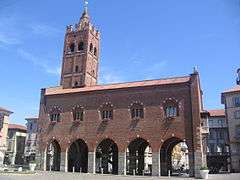Arengario

The Arengario (medieval town hall) of Monza
The Italian word arengario (also spelled arrengario or arengo; pl.: arengari, arrengari, arenghi) refers to government buildings of different historic periods.[1] The word comes from the verb "arringare" ("to address"), as arengari usually have balconies from which the authorities would address the population in public speeches.[2]
The word originally indicated the town hall of Italian medieval communes, especially in Northern Italy.[2] It was reintroduced during the Fascist era, also to refer to local governments seats, such as the seat of the podestà (mayor).[3] As a consequence, a number of both medieval and modern (Fascist) buildings in different Italian cities are known as "Arengario". Notable arengari include:
See also
- "Broletto" (has a partially overlapping meaning)
Footnotes
This article is issued from Wikipedia - version of the 10/21/2013. The text is available under the Creative Commons Attribution/Share Alike but additional terms may apply for the media files.